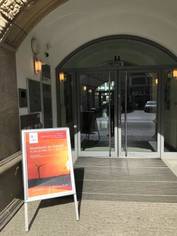For the sixth time already Energy Brainpool has hosted the symposium “Electricity Market of the Future”. From 21st to 22nd of March 2017 experts from business, science and politics discussed current topics of the German and European energy sector. The symposium revolved around the question how the electricity market could be further developed. In detail, future regulation mechanisms, energy storage, the future of short-term trading, possible price drivers in global commodity markets, as well as opportunities and risks of big data, blockchain and digitalisation were discussed.

The first day of the top-class event focused on various aspects of the electricity market design. Eike Dehning from dhng Consulting drew attention to the megatrends in ecology, society, technology, politics and energy and characterised the electricity market as the engine room of society. Dr. Peter Menck from the Federal Ministry for Economic Affairs and Energy (BMWi) explained what is coming after the electricity market law and the influence the law has on electricity market design. The electricity market law aims at free price setting and competition between all producers as well as flexibility options, taking into account the European perspective with regard to security of supply. The summary of the EU winter package was a great enrichment for many participants as well. Menck pointed out that in summer 2018, the ministry will publish a monitoring report on the electricity market and security of supply. Until then it will be examined how successfully the screws for security of supply have been adjusted.
“We are going towards the right direction,” said Volker Stehmann, Head of Markets & Renewables at Innogy, about the recently adopted EU winter package. However he would have wished that the electricity package would have been worked out together with the gas package, which is to be published next year. Then the important sector coupling could have been better integrated.
In the next item on the agenda energy storage systems were considered as a flexibility option. How can the (petrol/gas/electricity) station of the future look like? Dr. Kathrin Goldammer of Reiner Lemoine Institute dealt with this and other questions. She concluded that the transportation sector can provide enormous flexibility; however only if a corresponding charging infrastructure is built up in parallel.
In the further course of the event Dr. Hans Wolf von Koeller (STEAG) reported on his experiences with regard to the use and economy of large battery storages. Battery storages are an elementary part of the energy transition as they can provide network and system stability. Dr. Christian Riessen from Deutsche Kreditbank AG (DKB) discussed the topic of energy storages from the perspective of a bank. He indicated that market demand for financing options have increased sharply. This challenges banks with regard to technology as well as market and pricing forecasts.
Experts from Likron, MKonline and Next Kraftwerke concluded the first day with their presentations on the future of short-term trading. Dr. Henryk Pinnow of Likron summarized in his talk on trading robots that the traders’ tasks will shift from active trading to monitoring, analysis of performance as well as the further development of strategies and systems. Human traders will not become obsolete though. In fact both trader and systems will probably become “colleagues”.
Dr. Blazej Radimski (MKonline) presented the latest trends in intraday trading. His extensive data analysis impressively showed how fundamental factors influence the intraday market and its prices. Amani Joas (Next Kraftwerke) completed the first day with his experience on balancing group management, especially with active short-term optimization along with its challenges. Furthermore he showed how internal flexibilities supplement intra-day trading.
The second day of the conference was characterised by discussions about commodity markets in 2030 and which factors will drive future prices. Angela Pietroni of Energy Brainpool came to the conclusion that the decarbonisation of the transportation sector through electrification requires a stronger expansion of renewable energies, especially wind and solar power. She visualised the price signals for flexibility options and pointed out that long-term solutions are required.
Dr. Torsten Boschoff (Trianel) reported on whether gas power plants are still able to be in the money. The situation of German gas power plants is dramatic: The challenges are high, because contribution margins have to be earned during ever less operating hours. Gas-fired power plants often run in minimal operation only. He still regards highly efficient gas-fired power plants as part of the energy transition. However the regulatory framework of the CO2-market has to be adjusted.
Jana Ohlendorf made the audience watch beyond Europe towards China. She impressively presented the new energy policy of the Asian giant – no easy task to present such a complex topic in only 45 minutes.
The beautiful new world around Big Data, blockchain and digitalisation was the central point during the last block. The core issue of Prof. Dr. Jens Strücker of INEWI was: “Transaction costs when trading small volumes – Can blockchain help?” Afterwards, Thomas Koller (enersis europe) not only presented the challenges facing the Big Data, but also the possibilities and opportunities for collecting and processing huge amounts of data. In the energy sector only a few potentials have really been recognized yet. Dr. Merz of Proton concluded the symposium with his presentation on the first practical applications with blockchain solutions. The topic was quite new for some participants and showed once again what blockchain is, what it can do and where current limits are.
The sixth symposium was a great success for the participants, speakers and organizers. Important actors in the electricity sector intensively exchanged their views against the background of energy transition, the handling of changing market conditions, new regulations and long-term securing of profitability and security of supply of the energy market.



